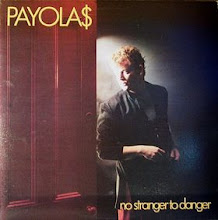
After the disappointment of Ridley Scott’s Robin Hood (2010), both as entertainment and as art, it was interesting to dip back into the work of Scott with Black Rain, a 1989 police thriller starring Michael Douglas. While a heavily flawed film, featuring lapses in logic and pulling out nearly every cop film cliché in the book, Black Rain is also a film which serves as a reminder as to just how visually powerful Scott’s work can be, especially in his 1980s heyday. Unfortunately, the impressive visuals also happen to go along with a confused and conflicted cultural and political subtext that borders on being xenophobic.
Black Rain’s narrative is the stuff of typical police thrillers: New York police officer Nick Conklin (Michael Douglas) is under investigation by internal affairs, when he witnesses the slaying of a Yakuza member in a restaurant along with his partner Charlie (Andy Garcia). The killer is another Japanese criminal, whom they capture. Forced to return the criminal to Japan, Conklin and Charlie act as curriers, only to accidentally turn the killer over to his own fellow criminals. Looking to make up for the mistake, Conklin and Charlie are forced to work with a Japanese detective named Masahiro (Ken Takakura), with the usual cross cultural misunderstandings taking place as they take to the streets to crack the case.
While the film is a police thriller, the real concern of the film is with the increasingly encroachment of capitalism, industrialism, consumerism and conformity upon the world, with Japan, and by extension its citizens, being a culture representative of these elements within the world of the film. Visually, Japan in the film is an industrial nightmare of oppressive buildings and advertisements,suppressing the personal for the supposed sake of society as a whole. Given this, it is no surprise that the opening image of the film is of the red sun of Japan’s flag being overlaid on a globe of the world, the first indicator of the film’s near racist paranoia of cultural invasion through globalisation. If not racist, the film is at the very least reductive in its portrayal of Japanese society and culture, playing up the noted “-isms” to the negation or submersion of other cultural attitudes and elements which make up Japanese society.
The fear of these “-isms” is given voice by Conklin, a detective who is something of a throwback to the cowboys of American mythology with his repeated resistance to “suits,” by any-means-necessary approach to policing, and visually in his navigation of urban, industrial spaces with his modern horse, a motorcycle. Conklin’s resistance to the forces of capitalism stems from a fear of being emasculated: divorced and attempting to keep his kids in private schools, Conklin has turned to occasionally skimming from the criminals he captures to function in the society he finds himself in. Conklin’s arrival in Japan places him in a society which, as already noted, has become a symbol for all these elements, increasing his feelings of distress and giving his rage a racist dimension as he becomes angered at the attempts to sideline him in the investigation.
In a different and much smarter film, Conklin’s behaviour and rage would have been explored while giving room to the possibility that his anger towards the noted “-isms” have a legitimate root. The narrative trajectory of Black Rain however is one in which the East and West move closer to one another, as represented in the relationship between Conklin and Masahiro, and as a result the film attempts to suppress or negate the thematic concerns with mixed results. An example is the way in which the film addresses the issue of Conklin’s theft from the criminals he captures, where Conklin explains that his theft was motivated by the needs of his family. While the film rightfully doesn’t allow this to justify Conklin’s behaviour, Conklin’s reasons and sense of emasculation in his inability to perform well in a consumerist society does hold a grain of legitimate criticism.
(SPOILERS)
However, such issues are brushed aside in the final as Conklin finally comes to wear a suit himself, now officially having “bought” into the mentality he has thus far detested. The film even goes a step further in having Conklin give a gift to Masahiro of a high end suit shirt (along with a certain plot device). Handled differently, this moment could have been a note of ambiguity, but instead, Scott presents the moment as one of bonding and light heartedness, failing to take note of the question of just how Conklin is, in his newfound state of being a brainwashed consumer, able to make his way without needing to steal. Instead, we are expected to simply accept this for the “happy” moment it is.
The film is also unable to rectify Conklin’s supposed transformation with the oppressive nature of the capitalist society, as visualized by the endlessly dominating cityscape of the film. The film never manages to convincingly give Conklin power over his environment, and thus instead allows him to regain a sense of masculine authority by being able to engage in his cowboy antics in an open, rural environment which descends into a one on one battle between Conklin and the film’s villain. Given this, Conklin more or less lucks out in being given an opportunity to police his way rather than successfully demonstrate any ability to function in the world around him. As such, the ending “transformation” is made all the more hollow and artificial, and more over, upholds an American sense of law enforcement and justice over the approach taken by the Japanese police in the film.
(SPOILERS DONE)
While the finished film is a thematic mess, upholding the values of capitalism, consumerism and industrialism while at the same time giving a half hearted critique of them, one could at least hope for a cohesive thriller narrative. Unfortunately, even the basic narrative is something of a mess, with lapses in logic, plot holes, plot conveniences and typical police procedure clichés. Given that Conklin is under investigation by internal affairs as the film starts, the very idea that he would even be allowed to leave the country is questionable, and the film’s subplot involving Kate Capshaw as an American bar tender in Japan serves little purpose beyond keeping the plot moving and giving Conklin some sort of romantic foil. Seeing as how the film never actually manages to give any screen time to this supposed romance however, it instead feels like a tacked element from another script, and the idea that Capshaw’s character would honestly be as well connected to the Yakuza as she is defies all sense of logic.
The film is furthermore done no favours in having Michael Douglas in the lead. While Douglas does capture the emasculated side of Conklin, Douglas performance more often than not is not that of a man raging against the world around him, so much as it comes across like a child throwing a temper tantrum. A scene is which Conklin supposedly gets down to business by searching a crime scene for clues is particularly glaring, as Conklin, without any rhyme or reason, merely starts destroying the area in broad sweeping gestures. Scenes such as this occur often in the film, and raise questions as to why he has any respect on the force at all, as there is clearly no real method to his approach. Thankfully, the rest of the cast aside from Douglas is able to keep the film afloat, though no one is given much to do in the film.
As much as I am ripping the film apart, there is one thing which ultimately holds the film together and makes it worth at least a rental, that being Ridley Scott’s visuals. Working with director of photography Jan De Bont, Scott creates a world that is utterly beautiful in just how bleak it is, mixing rich blacks and neon colour together in their representation of the city of Osaka. Every frame of this film is simply a stunner to look at, layered and full of life, even in the starkest of scenes. While it certainly doesn’t forgive the film’s other faults, the visual power of the film was such that I often was willing to go with the narrative just because of how beautiful the film looked. For those with Blu-ray players and HDTVs, Black Rain is worth every penny to see how good a film from that era can look.
Still, I can hardly make an honest recommendation of Black Rain beyond those fans of Scott. The film is simply too thematically confused and lacking in anything to make it engaging to be worth watching. The same however, cannot be said for another 1989 film looking at commercialism and consumerism: How to Get Ahead in Advertising, the film to be reviewed in the next few days.


No comments:
Post a Comment
What Is Your Cinematic Experience? Post Here!